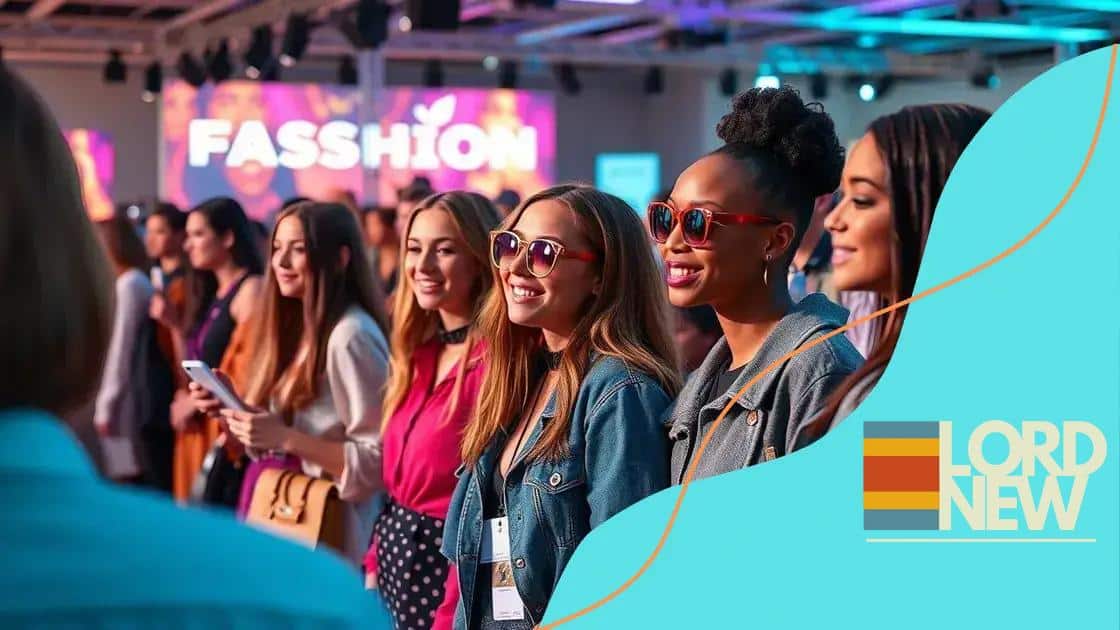Shein’s financial growth through influencer collaborations

Shein’s financial growth through influencer collaborations showcases how strategic partnerships enhance brand visibility, drive sales, and foster authentic connections with consumers in a competitive fashion market.
Shein’s financial growth through influencer collaborations is not just a trend; it’s a strategic cornerstone. Have you noticed how brands like Shein engage influencers? This article digs into the hows and whys of this relationship.
The rise of influencer marketing in fashion
The rise of influencer marketing in fashion has changed how brands connect with customers. In today’s digital world, traditional advertising has taken a backseat, giving way to social media influencers who have built strong relationships with their followers. This new strategy helps brands like Shein create authentic connections and reach wider audiences.
The Power of Social Media Influencers
Social media influencers are individuals who have gained popularity by sharing their lives and styles online. They often have loyal followers who trust their opinions, making them effective ambassadors for fashion brands. By leveraging such influencers, brands can promote their products in a relatable way.
Why Brands Choose Influencers
Brands are increasingly choosing influencer collaborations for several reasons:
- Influencers have a built-in audience that is often aligned with the brand’s target market.
- They provide authentic endorsements, which can lead to higher engagement and trust.
- Partnering with influencers is usually more cost-effective compared to traditional marketing methods.
As brands like Shein have discovered, the right influencer can turn a simple post into a viral marketing campaign. This happens when followers see influencers in daily life, wearing or using products they love, making them more likely to purchase.
Moreover, influencers often create unique content that showcases products in new and creative ways. This not only highlights the brand but also entertains the audience. For example, a fashion influencer might style outfits that show how versatile a piece can be, providing inspiration for potential buyers.
The nature of social media allows real-time feedback, so brands can quickly gauge the success of their campaigns. This instant interaction helps refine their strategies, ensuring that they stay relevant in a fast-paced market.
As influencer marketing continues to grow, brands must adapt and find the right partners. Understanding the dynamics of social media and the interests of targeted demographics is essential. By aligning with the right influencers, fashion brands can achieve remarkable growth and visibility.
Key performance indicators of influencer collaborations
Understanding the key performance indicators (KPIs) of influencer collaborations is crucial for brands like Shein. These metrics help measure the success and effectiveness of their marketing strategies. Without tracking these indicators, it’s challenging to know what works and what doesn’t.
Common KPIs for Influencer Marketing
There are several important KPIs that brands should focus on:
- Engagement Rate: This measures how actively followers interact with an influencer’s content. High engagement indicates a strong connection between the influencer and their audience.
- Reach: This refers to the total number of unique users who see the content. A larger reach can increase brand awareness significantly.
- Conversions: Tracking how many followers take action, such as making a purchase or signing up for a newsletter, is essential. This metric directly relates to ROI.
- Follower Growth: After campaigns, observing how many new followers the influencer gains can provide insights into brand interest.
By analyzing these KPIs, brands can refine their strategies to ensure successful partnerships with influencers. For example, if an influencer sees a great engagement rate but low conversions, this could indicate that their audience loves the content but isn’t interested in purchasing the product.
Moreover, brands can utilize social media analytics tools to gather data on these KPIs. This data helps brands understand the effectiveness of their campaigns over time. With insights in hand, adjustments can be made to optimize future collaborations for better results.
Success in influencer marketing goes beyond just metrics. It also involves understanding the target audience and how they perceive the influencers. This relationship plays a big role in how effectively a campaign can resonate with potential customers.
How Shein leverages social media influencers

Shein leverages social media influencers to create engaging marketing campaigns that resonate with their audience. By partnering with the right influencers, Shein effectively reaches millions of potential customers, amplifying brand visibility.
Selecting the Right Influencers
A key strategy for Shein is carefully selecting influencers whose style aligns with their brand. This ensures that the content feels authentic and relatable to the influencer’s audience. Shein often works with micro-influencers, who may have smaller followings but boast high engagement rates. These influencers can create personalized content that deeply connects with their fans.
Creating Engaging Content
When influencers showcase Shein’s products, they do so in a way that tells a story. Content often includes:
- Unboxing videos: Influencers reveal new products, generating excitement among viewers.
- Outfit styling: They display how to wear different pieces, offering inspiration to followers.
- Hauls: Sharing multiple products in a single video helps showcase versatility.
This engaging content encourages followers to follow the trend and consider purchasing items from Shein.
Furthermore, Shein encourages influencers to use unique discount codes for their followers. This not only drives sales but also helps track which influencer campaigns are the most effective. By offering discounts, Shein provides an incentive for followers to try their products.
Regularly collaborating with influencers also allows Shein to keep its brand on the current trends. These influencers often update their content to match seasonal styles and fashion trends, making Shein a go-to brand for stylish clothing. This approach keeps the audience interested and engaged.
Case studies: Successful partnerships and their impact
Exploring case studies of successful partnerships can reveal how influencer collaborations impact brands like Shein. Each collaboration tells a story of creativity, strategy, and measurable success.
Highlighting Key Partnerships
One notable example is Shein’s partnership with a group of fashion-focused influencers during a seasonal campaign. By these influencer’s unique styles, Shein was able to showcase its wide range of clothing options.
- Influencer Engagement: The campaign resulted in a significant increase in social media engagement. Posts featuring Shein products saw double the typical likes and comments.
- Sales Boost: The same campaign drove a notable rise in sales, with specific items selling out within days of the collaboration.
- Brand Awareness: Many influencers shared how they styled the pieces, reaching an entirely new audience. This not only broadened Shein’s reach but strengthened the brand’s position in the market.
Another successful case involved Shein collaborating with a well-known fashion influencer for an exclusive collection. The influencer’s followers craved a glimpse of the new styles, leading to increased site traffic and pre-orders before the launch.
Feedback showed that the collaboration resonated well with consumers, proving the effectiveness of personal brand alignment.
Such case studies highlight the importance of strategic influencer partnerships in boosting not just sales but also customer loyalty and community building around the Shein brand. Creatively engaging with audiences by harnessing the influence of popular figures is a powerful marketing tool.
Future trends in influencer collaborations for brands
The future of influencer collaborations for brands like Shein looks promising and dynamic. As social media continues to evolve, brands must adapt their marketing strategies to stay relevant and effective in reaching their audiences.
Emerging Platforms
With the rise of new social media platforms, brands are exploring collaborations on emerging platforms such as TikTok and Clubhouse. These platforms attract younger audiences and offer innovative ways to engage with potential customers.
- Short-Form Videos: TikTok allows for quick and creative content, enabling influencers to showcase products in entertaining ways.
- Audio-Driven Engagement: Clubhouse offers verbal interactions, creating deeper conversations around brands that resonate with listeners.
Brands are learning to tap into these platforms to maximize their reach and connect with diverse audiences.
Focus on Authenticity
As consumers become more savvy, authenticity in influencer partnerships will be pivotal. Brands that seek genuine relationships with influencers will likely see better engagement. Followers appreciate when influencers genuinely love and use a product.
Additionally, brands will focus on long-term collaborations rather than one-off posts. Long-term relationships help create a consistent brand presence and allow influencers to share more insightful experiences with the product.
Each collaboration has the potential to develop credibility in the influencer’s community, leading to stronger trust in the brand itself. Brands will also leverage analytics and data to tailor their influencer strategies, allowing for personalized marketing that speaks directly to target audiences.
Incorporating sustainability into influencer collaborations is another growing trend. As consumers become more environmentally conscious, brands that partner with eco-friendly influencers can enhance their image and attract conscious consumers. This evolution reflects a broader shift in values among today’s shoppers.
FAQ – Frequently Asked Questions about Shein’s Influencer Collaborations
How do influencer collaborations benefit brands like Shein?
Influencer collaborations boost brand visibility, create authentic connections, and can lead to increased sales through engaging content.
What are key performance indicators for measuring influencer success?
Key performance indicators include engagement rate, reach, conversions, and follower growth, helping brands assess campaign effectiveness.
Why is authenticity important in influencer marketing?
Authenticity builds trust with the audience, making influencers’ endorsements more impactful and leading to higher engagement and conversion.
What future trends should brands expect in influencer marketing?
Emerging social media platforms, a focus on sustainable practices, and long-term influencer partnerships are key trends brands should watch.





